HIST3H2A
| H2AW | |||||||||||||||||||||||||||||||||||||||||||||||||||
|---|---|---|---|---|---|---|---|---|---|---|---|---|---|---|---|---|---|---|---|---|---|---|---|---|---|---|---|---|---|---|---|---|---|---|---|---|---|---|---|---|---|---|---|---|---|---|---|---|---|---|---|
 | |||||||||||||||||||||||||||||||||||||||||||||||||||
| Identifiers | |||||||||||||||||||||||||||||||||||||||||||||||||||
| Aliases | H2AW, histone cluster 3 H2A, HIST3H2A, H2A.W histone | ||||||||||||||||||||||||||||||||||||||||||||||||||
| External IDs | OMIM: 615015; MGI: 2448458; HomoloGene: 137357; GeneCards: H2AW; OMA:H2AW - orthologs | ||||||||||||||||||||||||||||||||||||||||||||||||||
| |||||||||||||||||||||||||||||||||||||||||||||||||||
| |||||||||||||||||||||||||||||||||||||||||||||||||||
| |||||||||||||||||||||||||||||||||||||||||||||||||||
| |||||||||||||||||||||||||||||||||||||||||||||||||||
| |||||||||||||||||||||||||||||||||||||||||||||||||||
| Wikidata | |||||||||||||||||||||||||||||||||||||||||||||||||||
| |||||||||||||||||||||||||||||||||||||||||||||||||||
Histone H2A type 3 is a protein that in humans is encoded by the HIST3H2A gene.[5][6]
Histones are basic nuclear proteins that are responsible for the nucleosome structure of the chromosomal fiber in eukaryotes. Nucleosomes consist of approximately 146 bp of DNA wrapped around a histone octamer composed of pairs of each of the four core histones (H2A, H2B, H3, and H4). The chromatin fiber is further compacted through the interaction of a linker histone, H1, with the DNA between the nucleosomes to form higher order chromatin structures. This gene is intronless and encodes a member of the histone H2A family. Transcripts from this gene contain a palindromic termination element.[6]
References
- ^ a b c ENSG00000284841 GRCh38: Ensembl release 89: ENSG00000181218, ENSG00000284841 – Ensembl, May 2017
- ^ a b c GRCm38: Ensembl release 89: ENSMUSG00000078851 – Ensembl, May 2017
- ^ "Human PubMed Reference:". National Center for Biotechnology Information, U.S. National Library of Medicine.
- ^ "Mouse PubMed Reference:". National Center for Biotechnology Information, U.S. National Library of Medicine.
- ^ Marzluff WF, Gongidi P, Woods KR, Jin J, Maltais LJ (Oct 2002). "The human and mouse replication-dependent histone genes". Genomics. 80 (5): 487–98. doi:10.1016/S0888-7543(02)96850-3. PMID 12408966.
- ^ a b "Entrez Gene: HIST3H2A histone cluster 3, H2a".
Further reading
- El Kharroubi A, Piras G, Zensen R, Martin MA (1998). "Transcriptional Activation of the Integrated Chromatin-Associated Human Immunodeficiency Virus Type 1 Promoter". Mol. Cell. Biol. 18 (5): 2535–44. doi:10.1128/mcb.18.5.2535. PMC 110633. PMID 9566873.
- Deng L, de la Fuente C, Fu P, et al. (2001). "Acetylation of HIV-1 Tat by CBP/P300 increases transcription of integrated HIV-1 genome and enhances binding to core histones". Virology. 277 (2): 278–95. doi:10.1006/viro.2000.0593. PMID 11080476.
- Deng L, Wang D, de la Fuente C, et al. (2001). "Enhancement of the p300 HAT activity by HIV-1 Tat on chromatin DNA". Virology. 289 (2): 312–26. doi:10.1006/viro.2001.1129. PMID 11689053.
- Strausberg RL, Feingold EA, Grouse LH, et al. (2003). "Generation and initial analysis of more than 15,000 full-length human and mouse cDNA sequences". Proc. Natl. Acad. Sci. U.S.A. 99 (26): 16899–903. Bibcode:2002PNAS...9916899M. doi:10.1073/pnas.242603899. PMC 139241. PMID 12477932.
- Lusic M, Marcello A, Cereseto A, Giacca M (2004). "Regulation of HIV-1 gene expression by histone acetylation and factor recruitment at the LTR promoter". EMBO J. 22 (24): 6550–61. doi:10.1093/emboj/cdg631. PMC 291826. PMID 14657027.
- Zhang Y, Griffin K, Mondal N, Parvin JD (2004). "Phosphorylation of histone H2A inhibits transcription on chromatin templates". J. Biol. Chem. 279 (21): 21866–72. doi:10.1074/jbc.M400099200. PMID 15010469.
- Aihara H, Nakagawa T, Yasui K, et al. (2004). "Nucleosomal histone kinase-1 phosphorylates H2A Thr 119 during mitosis in the early Drosophila embryo". Genes Dev. 18 (8): 877–88. doi:10.1101/gad.1184604. PMC 395847. PMID 15078818.
- Wang H, Wang L, Erdjument-Bromage H, et al. (2004). "Role of histone H2A ubiquitination in Polycomb silencing". Nature. 431 (7010): 873–8. Bibcode:2004Natur.431..873W. doi:10.1038/nature02985. PMID 15386022. S2CID 4344378.
- Gerhard DS, Wagner L, Feingold EA, et al. (2004). "The Status, Quality, and Expansion of the NIH Full-Length cDNA Project: The Mammalian Gene Collection (MGC)". Genome Res. 14 (10B): 2121–7. doi:10.1101/gr.2596504. PMC 528928. PMID 15489334.
- Hagiwara T, Hidaka Y, Yamada M (2005). "Deimination of histone H2A and H4 at arginine 3 in HL-60 granulocytes". Biochemistry. 44 (15): 5827–34. doi:10.1021/bi047505c. PMID 15823041.
- Rual JF, Venkatesan K, Hao T, et al. (2005). "Towards a proteome-scale map of the human protein-protein interaction network". Nature. 437 (7062): 1173–8. Bibcode:2005Natur.437.1173R. doi:10.1038/nature04209. PMID 16189514. S2CID 4427026.
- Cao R, Tsukada Y, Zhang Y (2006). "Role of Bmi-1 and Ring1A in H2A ubiquitylation and Hox gene silencing". Mol. Cell. 20 (6): 845–54. doi:10.1016/j.molcel.2005.12.002. PMID 16359901.
- Bergink S, Salomons FA, Hoogstraten D, et al. (2006). "DNA damage triggers nucleotide excision repair-dependent monoubiquitylation of histone H2A". Genes Dev. 20 (10): 1343–52. doi:10.1101/gad.373706. PMC 1472908. PMID 16702407.
- Gregory SG, Barlow KF, McLay KE, et al. (2006). "The DNA sequence and biological annotation of human chromosome 1". Nature. 441 (7091): 315–21. Bibcode:2006Natur.441..315G. doi:10.1038/nature04727. PMID 16710414.
- v
- t
- e
-
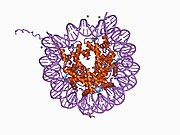 1aoi: COMPLEX BETWEEN NUCLEOSOME CORE PARTICLE (H3,H4,H2A,H2B) AND 146 BP LONG DNA FRAGMENT
1aoi: COMPLEX BETWEEN NUCLEOSOME CORE PARTICLE (H3,H4,H2A,H2B) AND 146 BP LONG DNA FRAGMENT -
 1eqz: X-RAY STRUCTURE OF THE NUCLEOSOME CORE PARTICLE AT 2.5 A RESOLUTION
1eqz: X-RAY STRUCTURE OF THE NUCLEOSOME CORE PARTICLE AT 2.5 A RESOLUTION -
 1hq3: CRYSTAL STRUCTURE OF THE HISTONE-CORE-OCTAMER IN KCL/PHOSPHATE
1hq3: CRYSTAL STRUCTURE OF THE HISTONE-CORE-OCTAMER IN KCL/PHOSPHATE -
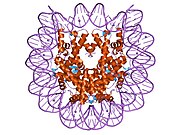 1kx3: X-Ray Structure of the Nucleosome Core Particle, NCP146, at 2.0 A Resolution
1kx3: X-Ray Structure of the Nucleosome Core Particle, NCP146, at 2.0 A Resolution -
 1kx4: X-Ray Structure of the Nucleosome Core Particle, NCP146b, at 2.6 A Resolution
1kx4: X-Ray Structure of the Nucleosome Core Particle, NCP146b, at 2.6 A Resolution -
 1kx5: X-Ray Structure of the Nucleosome Core Particle, NCP147, at 1.9 A Resolution
1kx5: X-Ray Structure of the Nucleosome Core Particle, NCP147, at 1.9 A Resolution -
 1m18: LIGAND BINDING ALTERS THE STRUCTURE AND DYNAMICS OF NUCLEOSOMAL DNA
1m18: LIGAND BINDING ALTERS THE STRUCTURE AND DYNAMICS OF NUCLEOSOMAL DNA -
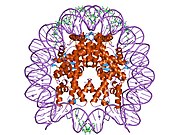 1m19: LIGAND BINDING ALTERS THE STRUCTURE AND DYNAMICS OF NUCLEOSOMAL DNA
1m19: LIGAND BINDING ALTERS THE STRUCTURE AND DYNAMICS OF NUCLEOSOMAL DNA -
 1m1a: LIGAND BINDING ALTERS THE STRUCTURE AND DYNAMICS OF NUCLEOSOMAL DNA
1m1a: LIGAND BINDING ALTERS THE STRUCTURE AND DYNAMICS OF NUCLEOSOMAL DNA -
 1p34: Crystallographic Studies of Nucleosome Core Particles containing Histone 'Sin' Mutants
1p34: Crystallographic Studies of Nucleosome Core Particles containing Histone 'Sin' Mutants -
 1p3a: Crystallographic Studies of Nucleosome Core Particles containing Histone 'Sin' Mutants
1p3a: Crystallographic Studies of Nucleosome Core Particles containing Histone 'Sin' Mutants -
 1p3b: Crystallographic Studies of Nucleosome Core Particles containing Histone 'Sin' Mutants
1p3b: Crystallographic Studies of Nucleosome Core Particles containing Histone 'Sin' Mutants -
 1p3f: Crystallographic Studies of Nucleosome Core Particles containing Histone 'Sin' Mutants
1p3f: Crystallographic Studies of Nucleosome Core Particles containing Histone 'Sin' Mutants -
 1p3g: Crystallographic Studies of Nucleosome Core Particles containing Histone 'Sin' Mutants
1p3g: Crystallographic Studies of Nucleosome Core Particles containing Histone 'Sin' Mutants -
 1p3i: Crystallographic Studies of Nucleosome Core Particles containing Histone 'Sin' Mutants
1p3i: Crystallographic Studies of Nucleosome Core Particles containing Histone 'Sin' Mutants -
 1p3k: Crystallographic Studies of Nucleosome Core Particles containing Histone 'Sin' Mutants
1p3k: Crystallographic Studies of Nucleosome Core Particles containing Histone 'Sin' Mutants -
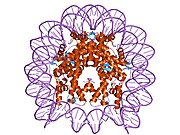 1p3l: Crystallographic Studies of Nucleosome Core Particles containing Histone 'Sin' Mutants
1p3l: Crystallographic Studies of Nucleosome Core Particles containing Histone 'Sin' Mutants -
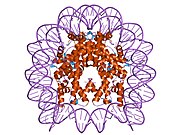 1p3m: Crystallographic Studies of Nucleosome Core Particles containing Histone 'Sin' Mutants
1p3m: Crystallographic Studies of Nucleosome Core Particles containing Histone 'Sin' Mutants -
 1p3o: Crystallographic Studies of Nucleosome Core Particles containing Histone 'Sin' Mutants
1p3o: Crystallographic Studies of Nucleosome Core Particles containing Histone 'Sin' Mutants -
 1p3p: Crystallographic Studies of Nucleosome Core Particles containing Histone 'Sin' Mutants
1p3p: Crystallographic Studies of Nucleosome Core Particles containing Histone 'Sin' Mutants -
 1s32: Molecular Recognition of the Nucleosomal 'Supergroove'
1s32: Molecular Recognition of the Nucleosomal 'Supergroove' -
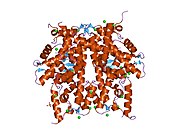 1tzy: Crystal Structure of the Core-Histone Octamer to 1.90 Angstrom Resolution
1tzy: Crystal Structure of the Core-Histone Octamer to 1.90 Angstrom Resolution -
 1zbb: Structure of the 4_601_167 Tetranucleosome
1zbb: Structure of the 4_601_167 Tetranucleosome -
 1zla: X-ray Structure of a Kaposi's sarcoma herpesvirus LANA peptide bound to the nucleosomal core
1zla: X-ray Structure of a Kaposi's sarcoma herpesvirus LANA peptide bound to the nucleosomal core -
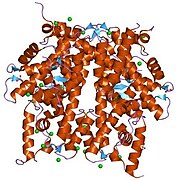 2aro: Crystal Structure Of The Native Histone Octamer To 2.1 Angstrom Resolution, Crystalised In The Presence Of S-Nitrosoglutathione
2aro: Crystal Structure Of The Native Histone Octamer To 2.1 Angstrom Resolution, Crystalised In The Presence Of S-Nitrosoglutathione -
 2cv5: Crystal structure of human nucleosome core particle
2cv5: Crystal structure of human nucleosome core particle -
 2f8n: 2.9 Angstrom X-ray structure of hybrid macroH2A nucleosomes
2f8n: 2.9 Angstrom X-ray structure of hybrid macroH2A nucleosomes -
 2fj7: Crystal structure of Nucleosome Core Particle Containing a Poly (dA.dT) Sequence Element
2fj7: Crystal structure of Nucleosome Core Particle Containing a Poly (dA.dT) Sequence Element -
 2hio: HISTONE OCTAMER (CHICKEN), CHROMOSOMAL PROTEIN
2hio: HISTONE OCTAMER (CHICKEN), CHROMOSOMAL PROTEIN -
 2nzd: Nucleosome core particle containing 145 bp of DNA
2nzd: Nucleosome core particle containing 145 bp of DNA
 | This article on a gene on human chromosome 1 is a stub. You can help Wikipedia by expanding it. |
- v
- t
- e















































